A Winter Tour today, on the North Norfolk coast. It was cold and generally rather overcast, a little misty at times later on, but mostly dry and with only light winds which meant we could make a good day of it. We met in Wells and worked our way west.
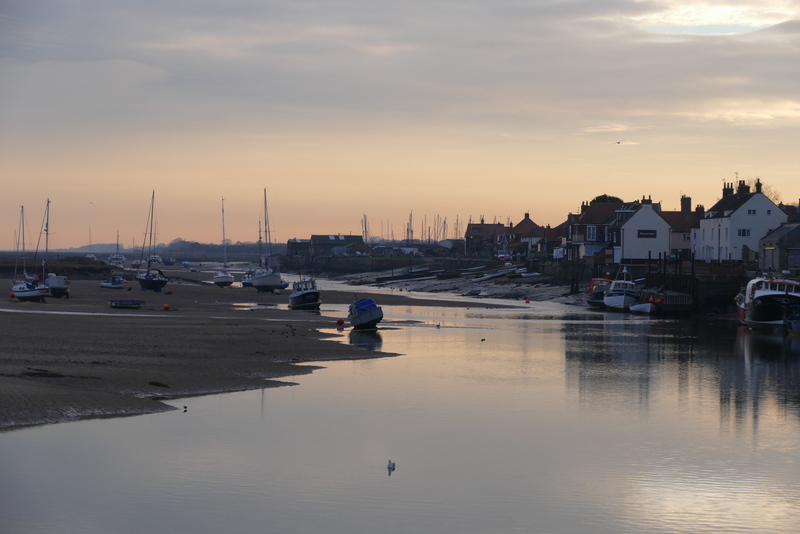 Wells Quay – at dawn
Wells Quay – at dawn
We had a quick stop down at the quay in Wells first. There was some lovely hazy sunshine out to the east first thing, before the cloud built. We had hoped to find the Shag which seems to have taken up residence in the harbour for the winter, but it was not in its usual place on the jetty when we arrived. We contented ourselves with admiring the Brent Geese bathing out in the harbour channel and loafing around on the sand bars, before drifting off over to the fields the other side of the harbour wall to feed.
 Brent Geese – bathing and loafing in the harbour at Wells
Brent Geese – bathing and loafing in the harbour at Wells
Scanning across to the other side of the harbour, we finally picked up the Shag, which was swimming further down along the quay, diving repeatedly in among the boats. It showed no sign of returning to its favoured resting place, so we drove further along to where we could get a better look at it. The Shag was diving just off the quay and surfaced with a large fish. After a couple of attempts to get it turned round the right way, it managed to swallow it. Two Cormorants were also fishing in the harbour, giving us a good comparison.
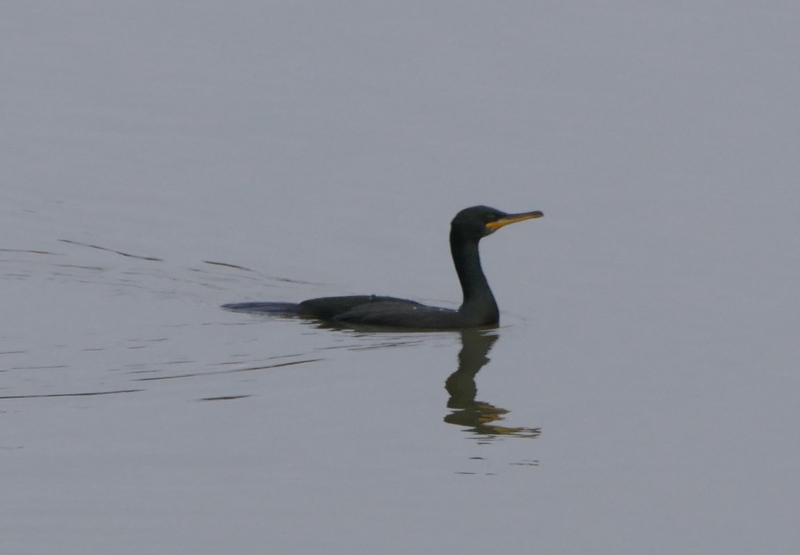 Shag – fishing in the harbour at Wells
Shag – fishing in the harbour at Wells
Our next stop was at Holkham. Just by the road opposite the church we pulled over to admire a little group of Pink-footed Geese on the grazing meadows. Most of the thousands which normally roost here overnight had flown off inland to feed already, but it was good to get a chance to study these few lingering geese more closely. One was sporting a small amount of white around the base of the bill, a not uncommon variant of Pink-footed Goose.
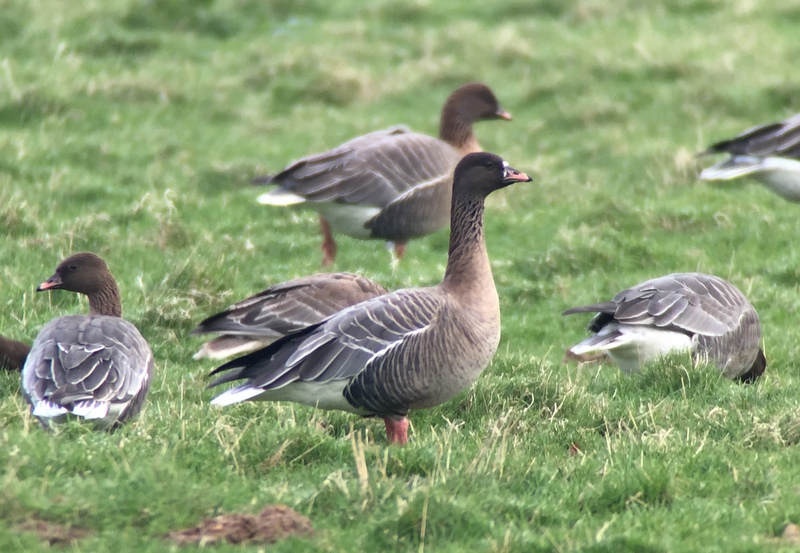 Pink-footed Geese – one had a small amount of white around the bill
Pink-footed Geese – one had a small amount of white around the bill
We couldn’t see any other geese with the Pinkfeet, but a little further along the road we stopped again and a scan of the grazing marshes revealed yet more geese. Many of them were Greylags – larger and paler with a big orange carrot of a bill. In amongst them were some White-fronted Geese, smaller and darker, with a noticeable white blaze around the base of the all pink bill. This white was much more extensive than on the single Pink-footed Goose we had just seen. The adult White-fronted Geese were also sporting distinctive black belly bars.
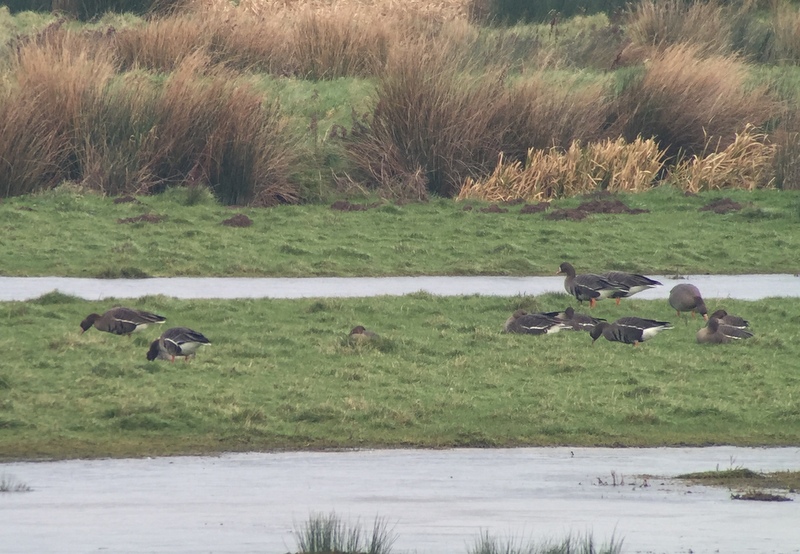 White-fronted Geese – out on the grazing marshes at Holkham
White-fronted Geese – out on the grazing marshes at Holkham
There were other birds to see here too. A Barn Owl was still out, flying back and forth over the marshes. It landed on a post for several minutes for a rest. Several Marsh Harriers circled overhead and two of them had a brief go at a Grey Heron which flew out of the trees and landed in the grass. A couple of Bullfinches flew along the hedge in front of us calling and landed briefly in the top of a tree.
We carried on our way west, stopping again briefly on the way to watch another Barn Owl which was hunting around some paddocks by the road. We diverted inland at Titchwell, around the back to Choseley, hoping to find the Rough-legged Buzzard which has made the area its home this winter, but there was no sign of it on our way past. We didn’t stop for any length of time. There were lots of Brown Hares in the fields and they are starting to chase each other round already – we even saw a very brief bout of boxing!
The hedges south of the barns have been full of Yellowhammers in recent weeks, but they were empty today. A tractor was working its way up and down the road flailing them back to the proportions of a rather small rectangular box, so the birds had flown. We decided to make our way back down to the coast and on to Thornham.
As soon as we arrived at Thornham Harbour we could see the flock of about 30 Twite, even before we got out of the car. They were buzzing around the saltmarsh right by the road. We pulled up and got out, just as they landed in the vegetation just behind us. We got them in the scope and had a quick look at them, but just at that moment some people tried to walk right up to them and they were off again, out onto the saltmarsh. The Twite came back shortly after, but were quickly flushed again and flew out towards the seawall. We gathered our stuff and set off in their direction.
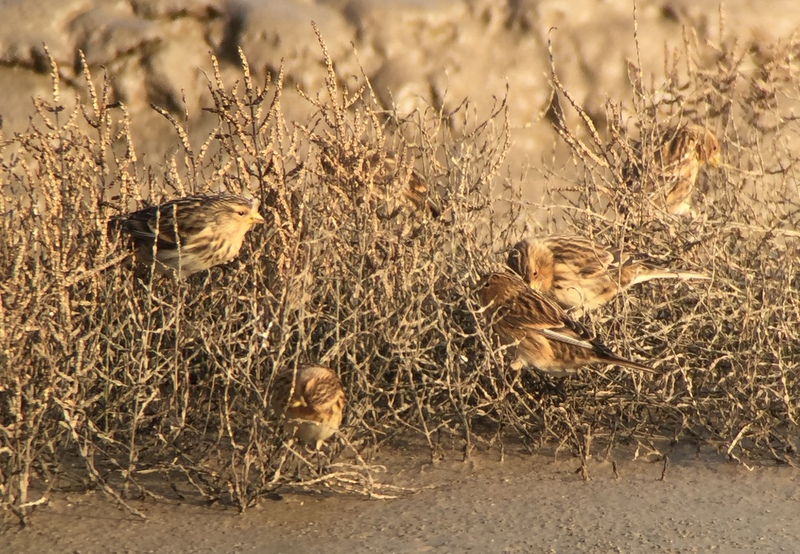
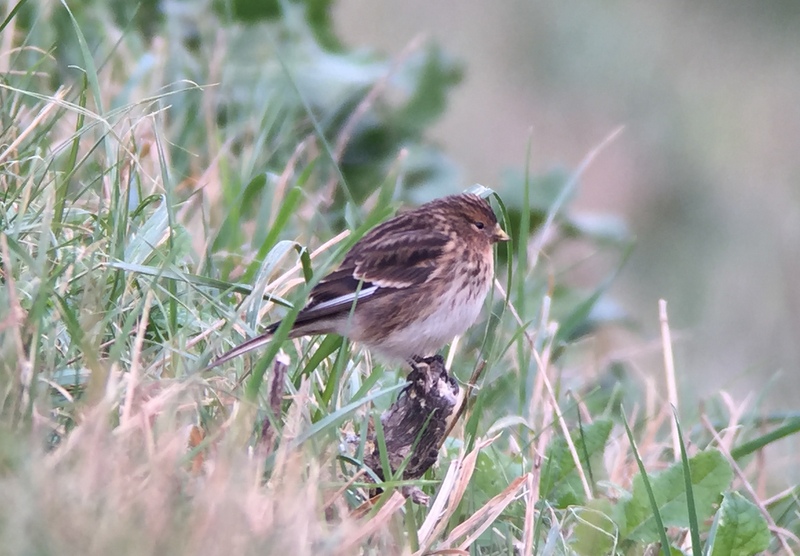 Twite – around 30 were still around Thornham Harbour
Twite – around 30 were still around Thornham Harbour
We could see the Twite again from up on the seawall, feeding on the edge of the saltmarsh just below us. Several of them were colour-ringed with individual combinations of coloured plastic rings which identify exactly where they have come from, mostly from the Pennines, with a couple from Derbyshire. We could see their peachy-orange breasts and small yellow bills. One – a male – was even showing off his pink rump! Two Reed Buntings were feeding around the low Suaeda bushes nearby.
We carried on out along the seawall towards the dunes at the east end of Holme beach. We had hoped to catch up with the three Shore Larks which are spending the winter out here, but there was no sign of them at first when we arrived. However, we hadn’t been there too long, when we spotted them flying in along the edge of the dunes from the direction of Holme and over our heads. There were quite a few people milling around on the edge of the beach which perhaps put them off, although that doesn’t generally seem to affect them, but the Shore Larks didn’t drop down onto the beach today and kept on flying inland until we lost them in the sun. Unfortunately, we would have to make do with a flypast as they didn’t reappear while we were there.
We had a look round while we waited. There were a few Goldeneye swimming around in the harbour channel. Out on the sea, we could see a good number of Great Crested Grebes and a single Red-breasted Merganser. A Red-throated Diver was diving constantly, which made it very hard to get everyone onto it. Down on the beach, the selection of waders included several Bar-tailed Godwits and a couple of Sanderling scuttling around on the sand. We decided to move on.
On the way back, some of the Twite were still feeding further out on the saltmarsh, a little less skittish now. A Red-breasted Merganser in the harbour channel gave us better views than we had had of the one out on the sea earlier. A Bar-tailed Godwit flew in and landed close to the seawall on the mud. A Knot was bathing further out in the channel.
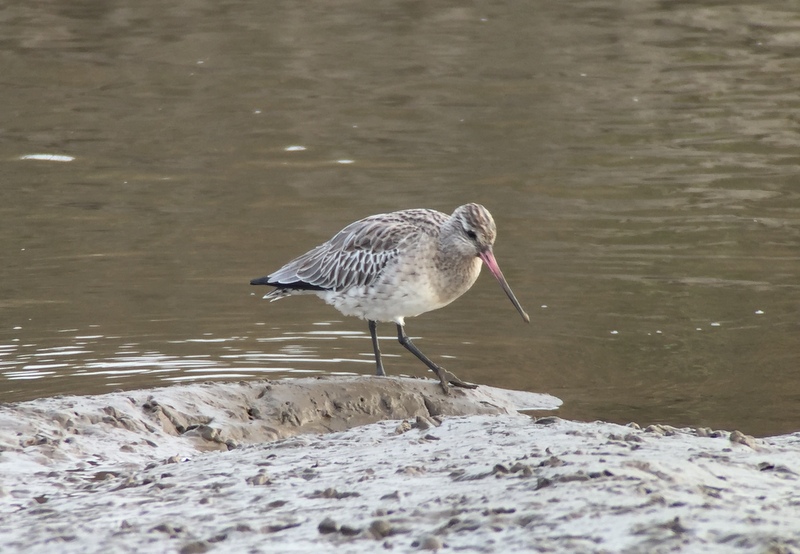 Bar-tailed Godwit – in Thornham Harbour
Bar-tailed Godwit – in Thornham Harbour
We planned to head on to Titchwell next, but on the way there we took a quick diversion inland. From an unflailed hedgerow by the road, we flushed a large flock of buntings which disappeared across the field to the other side. We pulled in and got the scope onto them – we could see there were lots of Corn Buntings and a smaller number of Yellowhammers. It was a real treat to see so many of these increasingly scarce farmland birds. The Corn Buntings were larger, and buffy-brown – we could even hear some of them singing already, a distinctive sound like jangling keys. Several of the Yellowhammers were very smart males with bright canary-yellow heads.
 Corn Buntings – we came across a large flock by the road
Corn Buntings – we came across a large flock by the road
From there, we made our way back round towards Titchwell. While checking for oncoming traffic at a road junction, we glimpsed a raptor crossing the road in the distance and disappearing behind a hedge. A quick turn round and drive out beyond the hedge and we could see it was the Rough-legged Buzzard, flashing its white tail with black terminal tail band as it flew away from us. Just when we had least expected it.
We watched the Rough-legged Buzzard heading out across the field, before it turned and made its way along a hedge at the back, showing us its black belly patch contrasting with its pale head as it did so. It then landed in a small tree and we got it in the scope. It was a way off by this stage, but still we got a good look at it. It was a nice bonus to find it along here, having not seen it around Choseley earlier.
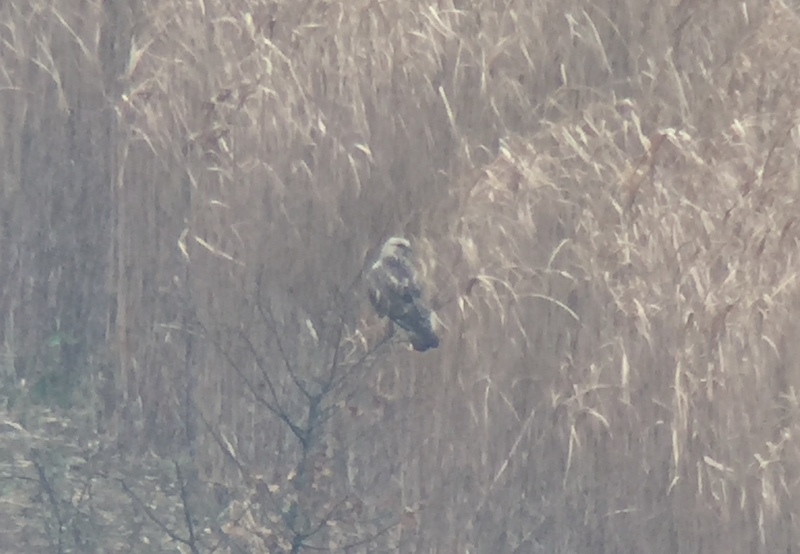 Rough-legged Buzzard – just when we least expected it
Rough-legged Buzzard – just when we least expected it
Then it was time for Titchwell. After a quick break for lunch, we set off to walk out onto the reserve. There were lots of finches on the feeders by the Visitor Centre, but the most notable was a single Brambling which was hiding in the bushes behind with a small group of Chaffinches. While we were watching it, the Barn Owl appeared over the grazing marsh beyond, but by the time we had torn ourselves away from the feeders it had disappeared again. The Water Rail in the ditch nearby disappeared into the reeds as we approached, unfortunately before everyone got a chance to see it.
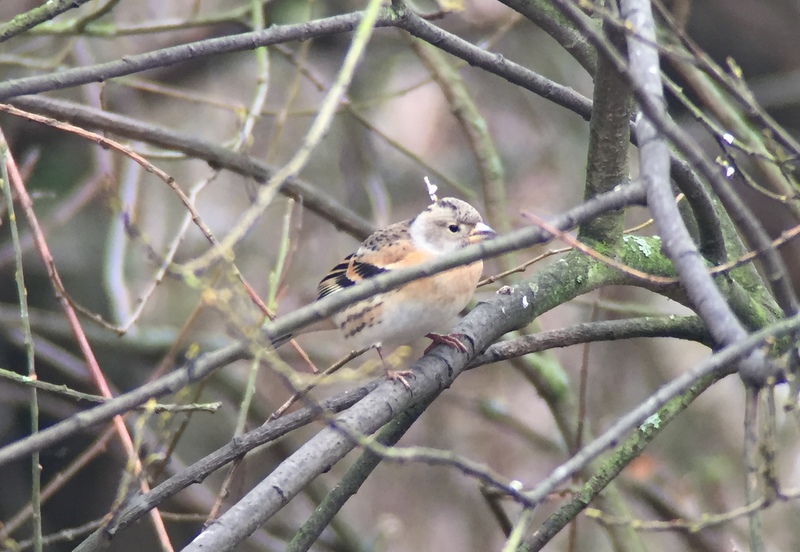 Brambling – by the feeders at Titchwell
Brambling – by the feeders at Titchwell
We stopped at the still dry grazing meadow ‘pool’. At first it looked fairly quiet, apart from a small selection of plovers – a Lapwing, a Grey Plover and a couple of Ringed Plovers. Looking from a different angle, we could see that there were actually several pipits out on the mud behind the reeds. We started to have a closer look through them but all we could find today was Rock Pipits. Then it started to drizzle a little, so we made for the shelter of Island Hide.
The water level on the freshmarsh continues to drop nicely, exposing more mud, although the birds don’t seem to be appreciating it yet. There is still a good number of Avocets on here for this time of year, and they were feeding more actively today rather than just sleeping, as were the Black-tailed Godwits. All around the edges of the exposed mud we could see a good smattering of Dunlin.
There are still plenty of ducks on the freshmarsh, particularly good numbers of Teal. Several smart drakes and their accompanying females were feeding in the mud below the hide. There were also still quite a few Shoveler and Mallard, but not so many Wigeon at the moment. The Wigeon prefer somewhere where there is more grass to graze on, so are often out on the saltmarsh.
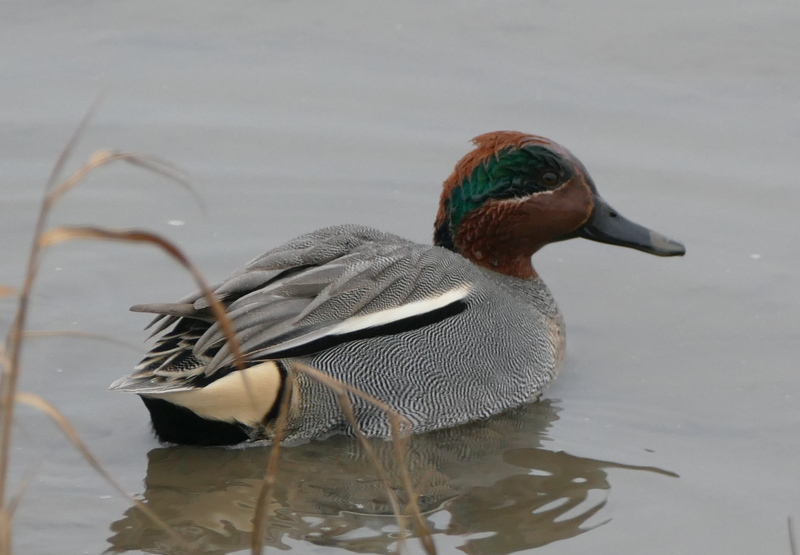 Teal – still lots on the freshmarsh
Teal – still lots on the freshmarsh
The weather had closed in a bit and it was starting to get rather grey and misty, even if the earlier drizzle had now eased off. We decided to head out towards the beach. The Volunteer Marsh produced a good selection of waders, as it has done in recent weeks. There are always lots of Redshank on here and normally a good number of Curlew too. A single Black-tailed Godwit was feeding along the edge of the deep channel by the path, very well camouflaged against the grey-brown mud, but giving us great up-close views.
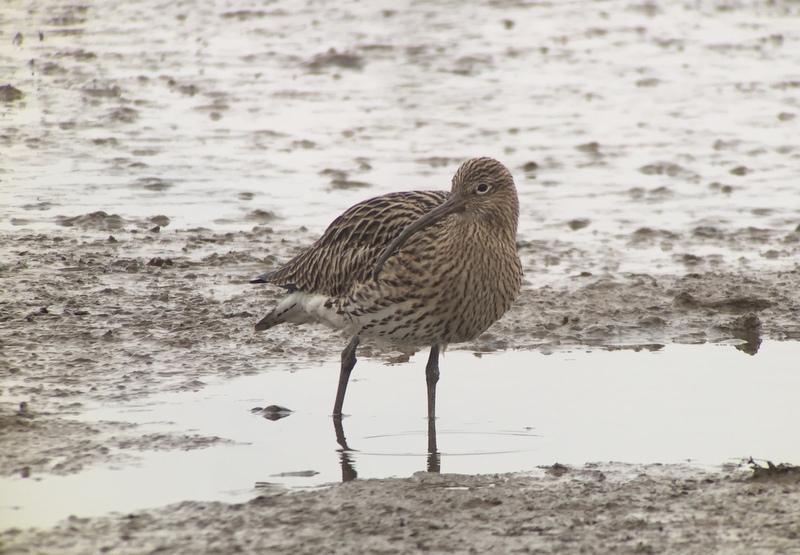 Curlew – the Volunteer Marsh is usually a good place to see them
Curlew – the Volunteer Marsh is usually a good place to see them
However, the stars of the show on the Volunteer Marsh were the plovers. There were several Grey Plovers out on the mud and through the scope we could admire their delightfully white spangled upperparts. One in particular had a long battle with a worm – the latter was understandably reluctant to leave its hole and the Grey Plover stood pulling at it, with the worm stretched out like an extension to its beak, for some time. A couple of much smaller Ringed Plovers were nearby and some similarly sized Dunlin flew in to join them, giving a good comparison.
 Grey Plover – very smart birds, even in winter plumage
Grey Plover – very smart birds, even in winter plumage
The Spotted Redshank was right at the back of the Tidal Pools as usual, but we got a clear view of it through the scope before it disappeared out of view. Noticeably paler silvery grey and white compared to all the Common Redshanks, with a longer and finer bill. Closer to the main path were a couple of Bar-tailed Godwits and two more Ringed Plovers.
The Pintail were back on the Tidal Pools today. A drake flew over as we were admiring the waders and disappeared towards the freshmarsh, but a pair and another couple of females were still busy upending out on the main pool further along towards the beach. We stopped to admire them in the scope.
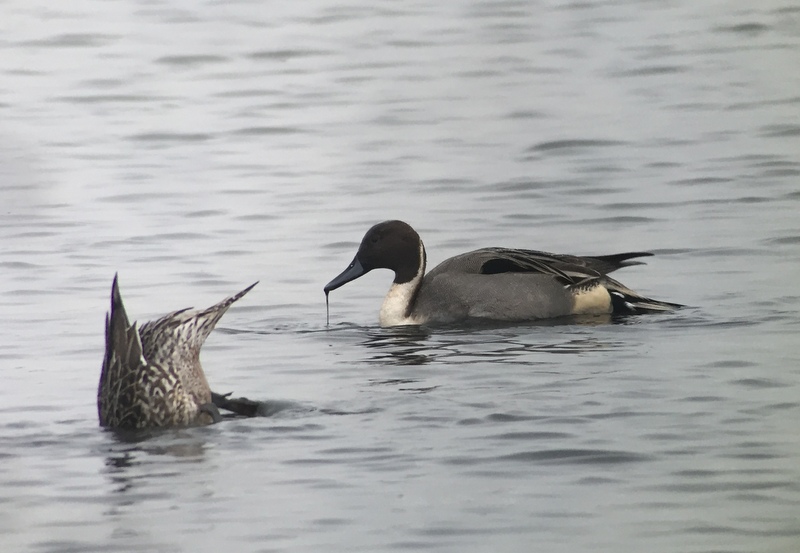 Pintail – this pair was on the Tidal Pools
Pintail – this pair was on the Tidal Pools
Out on the beach, the tide was well in. There were still quite a few Bar-tailed Godwits along the shoreline and plenty of Oystercatchers on the sand picking around the remains of the shells. It was a bit misty now, looking out to sea, but we found a line of Common Scoter out on the water on the edge of the cloud. Closer in, a few Red-breasted Merganser were swimming around just offshore. There didn’t immediately appear to be anything else of note, so we didn’t stay too long out there and started to make our way back.
As we walked back along the main path past the Volunteer Marsh, a particularly streamlined wader whipped in low across the mud, flashing a white tail and plain grey wings, a Greenshank. It dropped down out of view in the tidal channel at the back. Out on the freshmarsh, lots of Black-headed Gulls were starting to gather to roost.
We stopped for a short while to admire the Marsh Harriers out over the reedbed. The closer we looked the more we saw. There were several circling around and a few more perched in the dead trees over the back, in among all the Cormorants. A couple more flew in while we stood there – one high overhead from the direction of Thornham and a second low in from the back. At one point we counted ten Marsh Harriers all in view together.
We were losing the light quickly now, so made our way back towards the Visitor Centre. As we walked along, we scanned the ditches either side of the path. A Water Rail down in the bottom of the ditch on one side scuttled quickly into cover, but a second Water Rail on the other side was more obliging and spent a couple of minutes rooting around in the rotting leaves on the far bank. When a large – and rather noisy – group arrived behind us and stopped to ask us what we were watching, it hurried back into cover. We decided to do the same and headed for home.
















